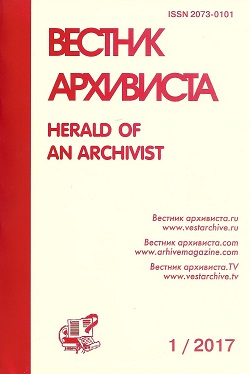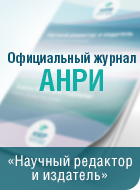Curbing the Time of Troubles: commemoration practices in the Russian provinces in 1918, based on materials from the State Archive of the Penza Region



Scientific article
doi 10.28995/2073-0101-2024-3-703-717
For citation
Sukhova, Olga A. (2024), Obuzdanie Smuta: praktiki commemoratsii v rossiyskoy provinces v 1918 gg. Based on the materials of the State Archive of the Penza Region, Herald of an Archivist, № 3, pp. 703-717, doi 10.28995/2073-0101-2024-3-703-717
Sukhova, Olga. A., Penza State University, Penza, Russia
Curbing the Time of Troubles: commemoration practices in the Russian provinces in 1918, based on materials from the State Archive of the Penza Region
Abstract
Based on the analysis of office documentation and materials of the periodical press, the article examines the functional features of the organization and conduct of the first mass festivals in revolutionary Russia. The relevance of the study is determined by the acceleration of the dynamics of memorial culture in the conditions of the spread of information technologies and digitalization of society. In this regard, the study of the regularities and specifics of the formation of collective memories and corresponding models of behavior in the era of the 1917 Revolution is of particular importance for solving the problems of modern memorial policy and the preservation of historical memory. The aim of the study is to analyze the socio-cultural content of commemorative practices in the conditions of the collapse of statehood and escalation of revolutionary violence in the Russian provinces. The source base is represented by the materials of the State Archive of Penza Oblast. The methodological tools are developed on the basis of the approaches of the history of everyday life, social constructionism and the history of memory. The sociocultural content of the mass political celebration is considered as the interaction of political, recreational and archetypal elements, which ensured the success of social adaptation and perception of new values and meanings. The political context of the celebrations and the representation of the new power were manifested in the idea of the world revolution, embodied in the red decor of public space, in the models of monuments to the founders of the revolutionary movement, in the organization of rallies, processions and military parades. Recreational resources (holding free concerts, performances, giving treats to children, etc.) were responsible for mnemic processes - remembering (imprinting) and preserving the historical memory of the events of the revolution. The archetypal purpose of the holidays of the first revolutionary year is connected with the desire to limit, to subject to oblivion the mass deviations of the revolutionary era. In Penza Province, unlike the metropolitan regions, the transformation of commemorative practices was dominated by the archetypal trajectory, which is explained by the specifics of historical development. The focus of the spatial organization of the “place of memory” was the administrative center of Penza - Sovetskaya (former Sobornaya) Square. A memorial to K. Marx was erected here on the eve of May Day celebrations, and fierce battles took place here during the rebellion of the Czechoslovak Corps (May 28-29, 1918). The funerals of the victims of the revolution and the appearance of the necropolis on the square created a new event frame of collective memories, designed to curb violence and chaos, to overcome the state of archetypal celebration. During the celebration of the first anniversary of the October Revolution in Penza, the worship of mass graves was complemented by the organization of a carnival procession and fireworks, which again points to the multilevel functionality of mass political events.
Keywords
Revolutionary violence, Soviet holidays, commemoration practices, historical memory, Penza Province, historical sources.
Download the article: sukhova_doi
References
Assman, A. (2023), Long Shadow of the Past: Memorial Culture and Historical Policy, Novoye literaturnoye obozrenie, 3 ed., Moscow, Russia, 328 p.
Assman, A. (2016), New discontent of memorial culture, Novoye literaturnoye obozrenie, Moscow, Russia, 232 p.
Kolesnik, M. A., Leshchinskaya, N. M., Omelik, A. A., Ermakov, E. K. (2023), Art of decoration of mass Soviet holidays (1918-1923), Journal of Siberian Federal University. Humanities, № 16 (11), pp. 1918-1935.
Lebedeva, L. V. (2015), Formation of Soviet holiday culture in the 1920s: new rituals in the process of social construction, Fundamental Research: scientific journal, № 2 (8), pp. 1784-1787.
Nezhigai, E. N. (2016), Realization of the functions of festive culture through revolutionary holidays in Soviet Russia (regional aspect), Vestnik of Kuban State University, № 6, pp. 36-39.
Plagenborg, S. (2000), Culture and Revolution. Cultural orientations in the period between the October Revolution and the era of Stalinism, Neva Magazine, St. Petersburg, Russia, 416 p.
Popova, V. N. (2019), The phenomenon of the revolutionary holiday: the history of emergence and oblivion, Bulletin of Culture and Arts, № 4 (60), pp. 58-65.
Rolf, M. (2009), Soviet mass holidays, ROSSPEN; Fund of the First President of Russia B. N. Yeltsin, Moscow, Russia, 439 p.
Sizova, A. Yu. (2022), Archetype of the holiday in the revolutionary events of 1917, Tula Scientific Bulletin. Series: History. Linguistics, vol. 1 (9), pp. 39-54.
Shalaeva, N. V. (2013), Soviet state holiday as a mechanism for the formation of a representative image of power and socio-cultural communication (1917-1920-ies.), Vlast, vol. 21, № 1, pp. 132-136.
Assman, A. (2008), Transformations between history and memory, Social Research: An International Quarterly of the Social Sciences, vol. 75, № 1, pp. 49–72.
Demina, V. (2021), Art decoration of the mass celebration of the First anniversary of the October Revolution in the history of participatory art, South-Russian Musical Anthology, № 4, pp. 6–11.
Edelman, M. J. (1971), Politics as Symbolic Action: Mass Arousal and Quiescence, Academic Press, Chicago, 188 p.
Frederick, C. (2004), Corney. Telling October: Memory and the Making of the Bolshevik Revolution, Cornell University Press, Ithaca and London, 301 p.
Geldern, J., von (1993), Bolshevik Festivals, 1917–1920, University of California Press, Berkeley, 316 p.
McDowell, J. (1974), Soviet Civil Ceremonies, Journal for the Scientific Study of Religion, vol. 13, № 3, pp. 265–279.
About the authors
Sukhova Olga A., Doctor of Historical Sciences, Professor, Penza State University, V.G. Belinsky Pedagogical Institute, Faculty of History and Philology, dean, Penza, Russian Federation, +7-927-289-20-41, This e-mail address is being protected from spambots. You need JavaScript enabled to view it
ORCID 0000-0003-0658-736X
Grant information
The study was funded by the Russian Science Foundation grant No. 22-18-20015. The power and society of the Penza Region in the XIII - XXI centuries: historical aspects of territorial integration and the formation of regional identity, https://rscf.ru/en/project/22-18-20015/
The article was received in the editorial office on 31.03.2024, recommended for publication on 20.06.2024.











